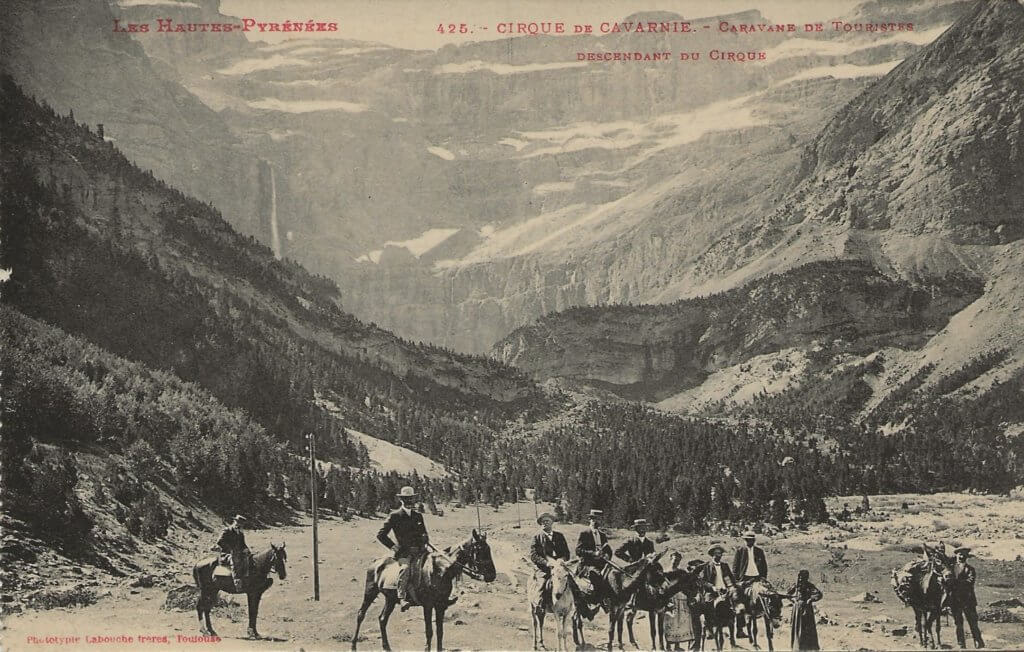Southern France, April 1919 [part 1]
Posted by Joel C. Swisher on April 9, '19
-

[Ed. Note: The first page of this letter is missing, and the last page ends abruptly in the middle of the page. Possibly he never finished and mailed it, but brought it home with him. The back story of the trip he describes is that while these unfortunate soldiers sat in miserable, rainy Brest, waiting to be sent back to the U.S., the Army decided that they could visit relatives on a furlough while they waited. Joel and his friend, Arbieter, decided that since they were in the northwest sector of France that they had “relatives” in the southeastern sector.Many years later while taking a night course in creative writing, some time in the 50’s or 60’s, he wrote this rough draft in pencil in a notebook. We are including it here as he recalls very vividly a beautiful memory:
“I shall never forget my first sight of real mountains.
“Imagine if you can, a couple of American soldiers on leave in southern France in the spring of 1919. For fifteen months we had seen very little but rain, mud, snow, and mud, and more rain. My buddy had done very well in some poker games, so we studied the map of France. We discovered the town furtherest from where we were stationed and asked for leave to go there and see our relatives, relatives that never existed. We traveled by easy stages, stopping at night so we would miss none of the country. It was after dark when we got into the City of Pau. The next morning I got up and looked out of the window. The hotel was on a hill.
“Immediately in front of us was a beautiful wide valley beginning to be batted in the early sunshine of a spring morning. In the distance a long brown wall rose thru a purple haze. Above the brown wall was a serrated line of white. It was several minutes before I realized I was looking at the snow covered mountains.
“Completely captured by the beauty of what we saw, a boy from the hills of Pennsylvania and his buddy from the prairies of Iowa, looked in silence for several minutes before we realized we were looking at the snow capped peaks of the Pyrenees.” ]
… about the middle of the forenoon. From Brest to Nantes we passed thru the province of Brittany. Very pretty with its hills and green valleys. The people of Brittany are different from the other French. In fact they are not French but Celtic. They have the features of the Irish and speak a dialect which is said to be understood by a Welsh man. The men wear broad rimmed hollnet[?] hats with a couple black ribbons down the back. The women wear white caps which are different in every locality. From Nantes to Bordeaux we passed through a very rich farming country with sail windmills and numerous vineyards.
We spent the second night in Bordeaux. We began to notice palm trees and other evidences of a semi-tropical climate. From Bordeaux we passed thru a level country with almost unending scrub pine forest. Nearly every tree was being tapped for rosin. Occasionally we would come to a clearing with rich fields of clover, rye and fruit orchards in bloom. Toward Bayonne we began to notice groves of them, the bark having been removed to about 6 feet from the ground.
Bayonne has a very old church and arena, also some very beautiful gardens. The heavy rainfall and warm climate cause a very heavy vegetation. About 5 miles from Bayonne is the noted fashionable summer resort of Biarritz. It is one of the most stylish places I have seen in France. We stayed a few hours in these two towns and went on to Pau for the night.
That is about the cleanest town I have been in in France. In it is the palace of Henry IV of Navarre built in 1532. Pau is built on a hill on the north side of the valley. In the morning when I looked out of the window across, I saw the snow clad peaks of the Pyrenees rising behind their foot hills. Quite a sight for me who had never seen anything higher than the Blue Ridge. From Pau we went a few miles up the valley to Lourdes where we stopped a day and a night.

Joel doesn’t mention visiting the Cirque de Gavarnie (a bowl-like valley). He probably bought this postcard in Lourdes or Toulouse.
Lourdes is a very interesting Catholic town. Famous for the visions of a peasant girl now known as St. Bernadette. The spring in the cave in which she had the visions has great healing properties for those of great faith. On the walls of the cave are a hundred or more pair of crutches of those who came there cripples, drank of the water and walked away cured. A very beautiful church has been built over the place by the contributions of Catholics in all parts of the world. Lourdes lies at the foot of the Pyrenees and is the Mecca for Catholic pilgrims.
[Continued in a later post]